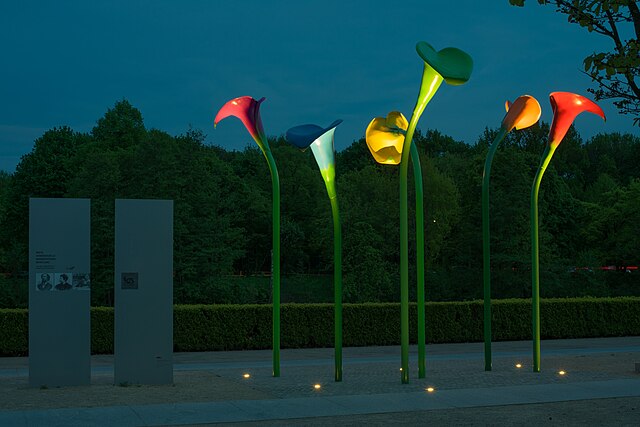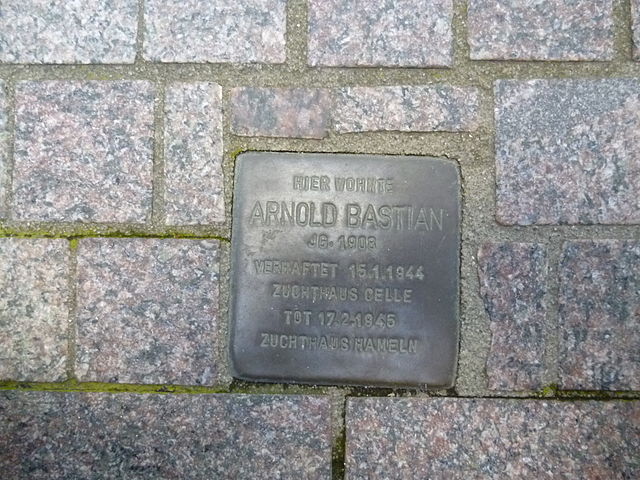First homosexual movement
The first homosexual movement was a socio-political movement which thrived in Germany from the late nineteenth century until 1933. The movement began in Germany because of a confluence of factors, including the criminalization of sex between men and the country's relatively lax censorship. German writers in the mid-nineteenth century coined the word homosexual and criticized its criminalization. In 1897, Magnus Hirschfeld founded the world's first homosexual organization, the Scientific-Humanitarian Committee, whose aim was to use science to improve public tolerance of homosexuality and repeal Paragraph 175. During the German Empire, the movement was restricted to an educated elite, but it greatly expanded in the aftermath of World War I and the German Revolution.
Memorial to the First Homosexual Emancipation Movement in Berlin-Moabit, unveiled in 2017
The single issue of the periodical Uranus published by Karl Heinrich Ulrichs in 1870
The Scientific-Humanitarian Committee's petition against Paragraph 175
Der Eigene cover from 1924
Persecution of homosexuals in Nazi Germany
Before 1933, male homosexual acts were illegal in Germany under Paragraph 175 of the German Criminal Code. The law was not consistently enforced, however, and a thriving gay culture existed in major German cities. After the Nazi takeover in 1933, the first homosexual movement's infrastructure of clubs, organizations, and publications was shut down. After the Röhm purge in 1934, persecuting homosexuals became a priority of the Nazi police state. A 1935 revision of Paragraph 175 made it easier to bring criminal charges for homosexual acts, leading to a large increase in arrests and convictions. Persecution peaked in the years prior to World War II and was extended to areas annexed by Germany, including Austria, the Czech lands, and Alsace–Lorraine.
![Memorial in Nollendorfplatz, Berlin. Text in triangle: "Struck Dead Hushed Up [dedicated to] The homosexual victims of National Socialism" Text below:](https://upload.wikimedia.org/wikipedia/commons/thumb/0/07/Gedenktafel_Rosa_Winkel_Nollendorfplatz.jpg/439px-Gedenktafel_Rosa_Winkel_Nollendorfplatz.jpg)
Memorial in Nollendorfplatz, Berlin. Text in triangle: "Struck Dead Hushed Up [dedicated to] The homosexual victims of National Socialism" Text below: "The 'pink triangle' was the sign with which the National Socialists marked homosexuals in the concentration camps in a defamatory way. From January 1933 almost all homosexual locales in and around Nollendorfplatz were closed by the National Socialists or misused by raids to create 'pink lists' (homosexual files)."
Eldorado (pictured in 1932), the most famous gay establishment in Germany
Stolperstein of Kurt Wilcke (1908–1944); imprisoned for his homosexuality in Fuhlsbüttel concentration camp [de]; later transferred to a penal battalion; died during the Battle of Narva.
Arnold Bastian (1908–1945) was arrested in 1944 for his homosexuality and died in prison in 1945.





![Memorial in Nollendorfplatz, Berlin. Text in triangle: "Struck Dead Hushed Up [dedicated to] The homosexual victims of National Socialism" Text below:](https://upload.wikimedia.org/wikipedia/commons/thumb/0/07/Gedenktafel_Rosa_Winkel_Nollendorfplatz.jpg/439px-Gedenktafel_Rosa_Winkel_Nollendorfplatz.jpg)

![Stolperstein of Kurt Wilcke (1908–1944); imprisoned for his homosexuality in Fuhlsbüttel concentration camp [de]; later transferred to a penal battali](https://upload.wikimedia.org/wikipedia/commons/thumb/e/e6/Kurt_Wilcke_-_Mildestieg_27_%28Hamburg-Barmbek-Nord%29.Stolperstein.nnw.jpg/600px-Kurt_Wilcke_-_Mildestieg_27_%28Hamburg-Barmbek-Nord%29.Stolperstein.nnw.jpg)
